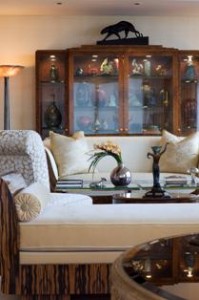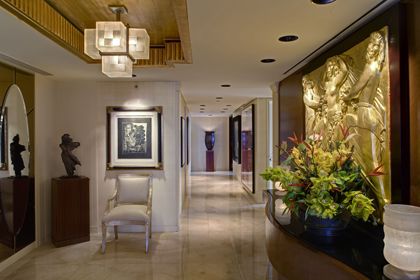
For the Designer
Always, always let your client know if you want to work with them on their art collection, discuss your knowledge with them and whenever possible, show them art and artifacts as part of the shopping experience and always make room for this in the budget. If you are not comfortable in doing this, there are plenty of consultants with the expertise to help you bring this to a wonderful conclusion. Understand that art can be the most important portion of the project and can also be the most costly. Most clients won’t want you to help them do this, but you will need to learn what their intentions are about the inevitable results of having either bad or no art in their homes. Also, “Decorative Art†is usually terrible, so look for galleries who specialize in original paintings, antique pieces, artifact collections and learn what galleries are reputable and those which are not.
If you don’t do anything with the artwork, you may have your entire project slide down the drain when they hang those velvet paintings of Elvis…be forewarned.
For The Client
It is understandable you feel your art is personal…all of us do, however your designer can be a resource for you so discuss how you wish to handle this at the beginning of your interview in order for your designer to understand where you stand on this issue. If the designer wants to help you an you don’t want to have to pay for this time billing, ask if you can do the shopping and pass your ideas on to them for their review. While this may work for you, the designer has no idea of what you will want to hang and I have seen many homes be rejected by editors because of the art collections and unless you really know what you are doing and have invested yourselves in learning about art, your concepts of good art are not necessarily up to the standards of most gallery owners. It would be most wise to visit a lot of galleries and discuss their art with the curators and gallery owners to understand why these pieces are considered “good†art. Most of what you see will not interest you, but you will learn a lot and quite possibly become a fan.
Also, conventional wisdom prevails…if your designer has been in the field for a while, they have seen good and bad art and most likely will be able to guide you or at least point you in the right direction of a few great galleries which will work with what you and your designer are doing.
For the Designer and Client
Usually I would not buy a lot of art at the local art fairs, but Art Chicago or Artropolis at the Merchandise Mart has such a broad spectrum of galleries and artists, you can find new and emerging artists to well established artists as well as vintage works and a wide array of pieces ranging from paintings, tapestries, sculptures, artifacts and even new and interactive pieces to help broaden your viewpoint….It’s all good for you and your designer, so ask him/her to go with you so you both can discuss what would be great in your space…remember, your designer knows scale, color and has a style for which you hired them.
Currently Cannon Frank is working with several clients who have large and established art collections and since we have broadened their viewpoints with regards to antiques and high-end furnishings, they have also found their taste in collecting art has also taken an up-swing on the “learning curveâ€. They know the simple fact that there is so much art to see and to enjoy, and we are proud to have had this influence on them and while they still love to collect for themselves, we are consulted on most of the pieces as well as the placement and if something doesn’t work, they now are willing to “trade up†to items which will work best with their décor.
Art is part of the décor whether the art comes first, is a wonderful existing collection or is something you will endeavor for many years to come…just include your designer for a better overall look.
